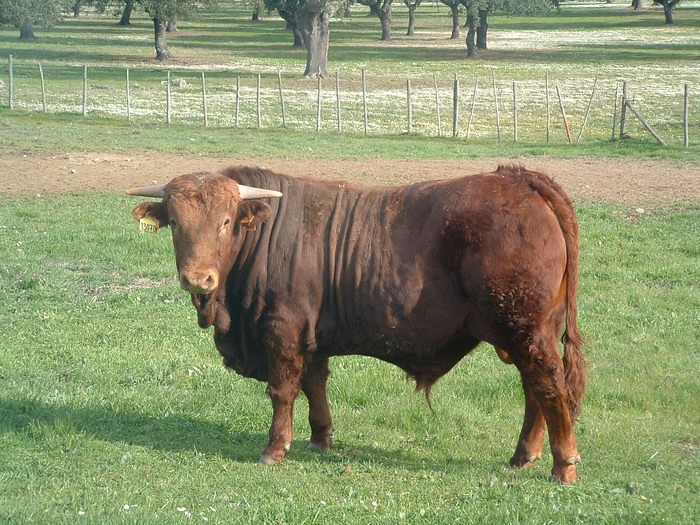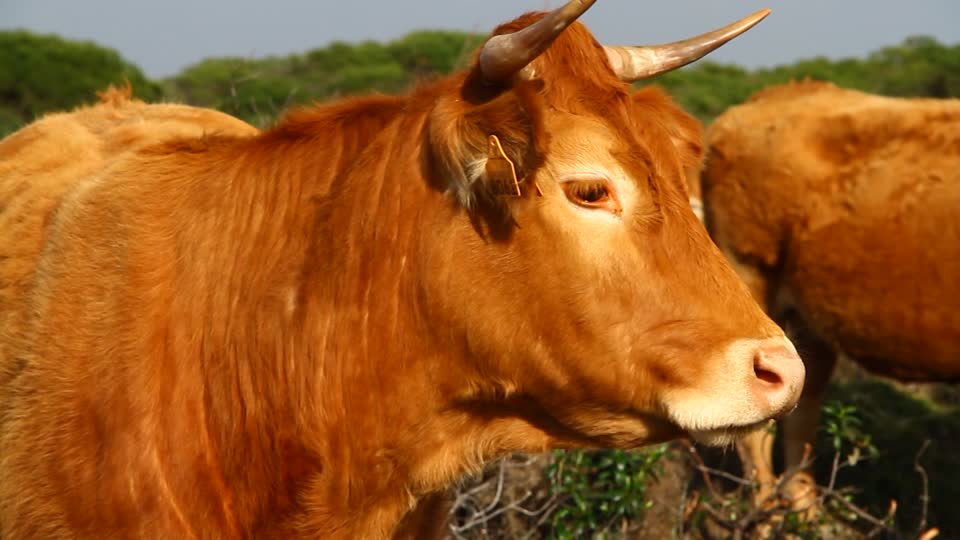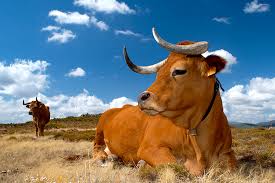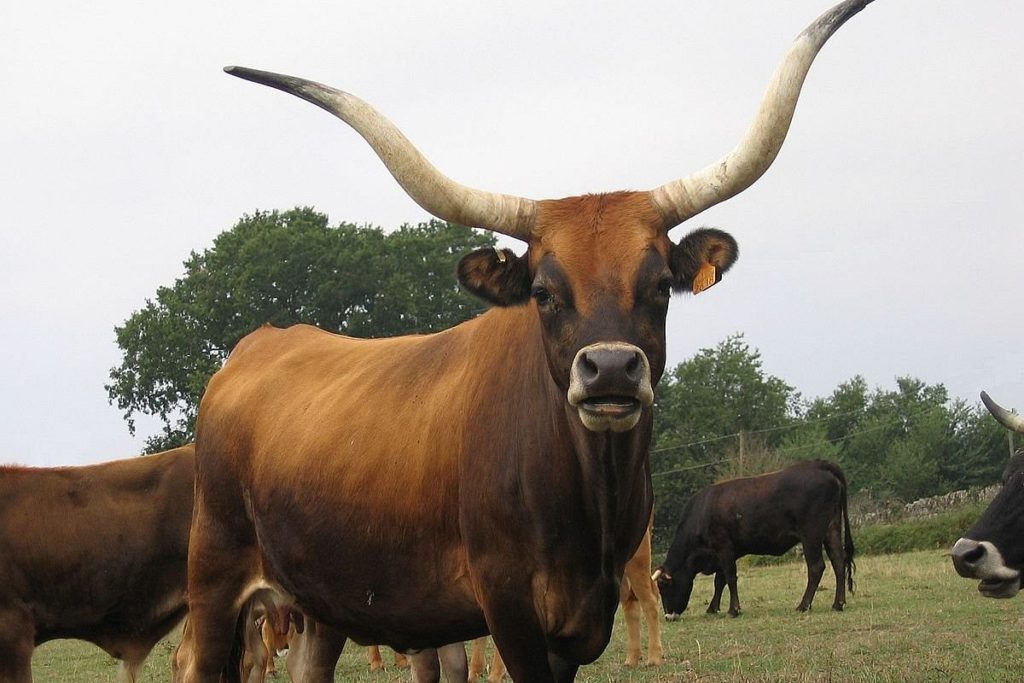Alentejana
The breed region is circumscribed almost exclusively to the Southern Portuguese Region of Alentejo, in both, High and Low Alentejo.
The race is represented by rustic, energetic and gentle animals that in the recent past were used to work.

- Forehead – slightly convex, especially in the transverse direction.
- Ears – Well set, horizontal and covered with long hairs on its inner surface.
- Eyes – The flower of the faces.
- Bevel – Slightly convex, or even straight, and well delineated.
- Faces – dry, leaving the muzzle posted.
- Muzzle – Developed, with mirror staining identical to that of other mucosal or slightly pigmented.
- Neck – In males, is thick, short, horizontal, provided with a barb that extends to a large fold from the chin to the cilhadouro, with only a slight slowdown after last the throat area. In females, is much less thick, narrow upper lip and barbless developed.
- Withers – Medium in width and slightly protruding.
- Back – Long and moderately wide.
- Loin or kidney – For wide.
- Croup – long, of good width and anterior muscular regularly.
- Tail – Fine, falling in a regular smooth curve from its insertion and finished a tassel and hairy.
- Breaststroke – For outstanding.
- Backing – Alto, slightly convex, but extending and rounding gradually as approaches the abdominal region.
- Flank – Short.
- Udder – for developed and regularly implemented.
- Lining – Long and developed.
- States – Of medium size and thickness, and mus guided and regular upright.
- Shoulder – Long and wide.
- Arm and forearm – Strong.
- Thigh – long and large but shallow muscle mass.
- Buttocks – for tending to decline and arched.
- Extremities (hands and feet) – solid, wide joints.
- Nails – Well shaped, solid and smooth, whose colour ranges from amber to fiery.
Algarvia

Algarvia cattle are native to the Algarve region of southern Portugal and were first represented in 1868, Based on its morphology, the breed has been classified in the Aquitanian (or Red Convex) group, together with Alentejana, Mertolenga, Garvonesa and Minhota. Except for Minhota, these breeds are distributed throughout the southern river Tagus valley. Algarvia cattle were used predominantly for meat production and/or draft. Although they were never formally registered as an independent breed, 25,000 – 29,000 animals were officially catalogued between 1940 and 1970. Since then, the population has declined rapidly and the breed was considered to be effectively extinct by the 1980s, an event that subjected the Regional Agricultural Authorities to criticism for failing to implement proper conservation measures.
Arouquesa

The Arouquesa is a cattle breed from Portugal. The Arouquesa breed was granted protected geographical status of DOC (Denominação de Origem Controlada) from the European Commission.
The cows reach a height of 1.23 m (4.0 ft), the bulls 1.36 m (4.5 ft), so the Arouquesas can be described as small. The breed’s weight is around 360–430 kg (790–950 lb). Their hair colour is light brown although the males may become a little darker than females. Mucosa and claws are dark coloured. The wide horns are directed forward, first down and then up.
Arouquesas are adapted to the mountains – their hind legs are very muscular. In Portugal today they still work as draught cattle. In the past century oxen often were exported to Great Britain because of their beef. In 1902 Arouquesa beef was the winner of the “Award for the Best Beef” in Paris. Unfortunately this excellent, fine marbled beef today is only known in Portugal. There they count as the best native breed for beef production. The animals are very long-living; 16–18 calves per cow are not uncommon. Most times they practice mother cow husbandry. The animals are very affable but active.
The breed region is circumscribed almost exclusively to the Northern Portuguese districts of Viseu, Aveiro, Porto, and Braga.
Barrosã

Barrosã cattle breed is native of Portugal. It is known mainly for its big distinctive horns, which can grow well over 100 cm in length. Ancestral inhabitants of the highest lands of northern Portugal, these animals graze freely on traditional pastures and marshes in conditions that are ideal for their welfare. The cattle enjoy a purity of nature that is characteristic of these places, contributing greatly to the preservation and biodiversity of the landscape as well as to the rural economic sustainability.
During the beginning of the 20th century, these cattle were numerous, registering more than 200,000 animals. But due to the industrial revolution, the appearance of machines and commercial breeds (more productive for meat and milk production), the animal became rarer and rarer, until 2005, when there were only about 7,000 left.
The protection of Carne Barrosã, which has a PDO recognition, contributes significantly to the preservation of a remarkable national heritage and the success of a local economy.
The meat of Barrosã Cattle has a very appealing red blood colour, giving the cuts of meat a slightly wet and marbled aspect. The combination of the genetic characteristics associated with an exclusive feeding plan based on maternal milk, foraging and grain allows the early infiltration of fatty acids into the interior of the muscle fibres, giving the meat a succulence, tenderness and unique flavour of recognized international merit.
The great balance of unsaturated fatty acids, omega-3 and omega-6, the low proportion in cholesterol and the unusual amount of antioxidant substances (alpha tocopherols and B-carotenes) provide, altogether, an important source of healthy micronutrients. The Barrosã beef is held to a rigorous system of food safety, guaranteeing the authenticity and traceability from “farm to fork”.
Like many other kinds of beef, Barrosã meat is excellent when grilled: seasoning it with salt, and cooking to rare or medium-rare will bring out its excellent flavour and tenderness.
Brava de Lide
Brava dos Açores
Cachena

The Cachena is a breed of triple-purpose cattle from Portugal and Galicia, Spain. In Portugal, there is also the similar but larger cattle breed known by the name, Barrosão or Barrosã. Cachena and Barrosã are sometimes considered variants of the same race.
Cachena cattle were bred from brown and yellow local cattle in Northern Portugal and Galicia (Spain). They are light brown to yellow with dark brown nuances around the withers. The mucosas are unpigmented except for the dark muzzle. The wide and longhorns are lyre-shaped. Cachena cattle are one of the smallest cattle breeds of the world: The height must be equal or less than 110 cm (both in cows and bulls, with the last ones, being normally taller). Bulls weigh around 550 kg, cows 390 kg.
Cachena cattle were originally bred in the Vila Real District, an agriculturally poor district in the extreme north of Portugal and later were exported to Galicia (Spain). Climate is hot and dry in summer, cold and humid in winter. The grounds are arduous and little fertile. The Cachena cattle are distributed around the low mountain range regions of the communities in the Spanish natural park Baixa Limia-Serra do Xurés in the frontier region to Portugal. Also, they are spread in the region around the Ourensic village Olelas and the Portuguese Peneda-Gerês National Park.
Garvonesa
The Garvonesa is a cattle breed originating in Portugal, The coat is normally dark red or brown. The head and neck are normally very dark. The Horns are typically developed, based on head-back and down, then up to frentee.
The breed region is circumscribed exclusively to Southeast Portugal in Beja and Setubal district.
Jarmelista
The Jarmelista is a cattle breed from Continental Portugal, near Serra da Estrela. It is primarily used for beef, The breed region is circumscribed exclusively to Central Portugal in Guarda district.
Marinhoa
The Marinhoa is a cattle breed from Portugal.
A large animal with harmonious forms. Thick elastic and prominent skin; light brown coat, tending to straw; docile temperament; long and flat head; bulky but not large abdomen; long wide and deep back and topsides; muscled members, strong, with good angulation; dark mucous; small horns; sub-concave profile.
The breed region is circumscribed almost exclusively to Central Portugal in Aveiro District.
Maronesa
The Maronesa is a traditional Portuguese breed of mountain cattle. Its name derives from that of the Serra do Marão, which lies in the Trás-os-Montes and Douro Litoral regions in the northern part of the country. Its primary use is for draught power.
The origin of the Maronesa is not clear and remains controversial. Historical evidence suggests that it derives from cross-breeding of the Barrosã and Mirandesa breeds, and it was considered a cross-breed until about 1835 when it was acknowledged to be a separate breed. Support for descent from Barrosã and Mirandesa comes from a 1993 study regarding the frequency of the 1/29 Robertsonian translocation in the three breeds, where the value for the Maronesa (~40%) is intermediate between that for the Barrosã (65%) and that for the Mirandesa (below 2%). A study published in 1998 found it to have a substantial genetic distance from the Barrosã, the Mirandesa, and all other breeds of northern Portugal and Galicia,micro-satellite analysis of Portuguese breeds in 2004 grouped it most closely with the Barrosã. The Maronesa was formerly numerous in the provinces of Douro, Minho and Trás-os-Montes, and particularly in the Serra do Alvão, the Serra da Padrela [pt], and the Serra do Marão. There is no census data from before 1940 when just over 25 000 head were counted; in 1955 there were 32 252 animals registered, and in 1972 there were 29 276. Numbers later dropped.
The Maronesa is traditional rustic cattle breed. It shows morphological similarity to the Portuguese fighting bull, the Brava de Lide, with marked sexual dimorphism: mature bulls are larger than cows, have a more heavily muscled neck and tend to show more development in the foreparts compared with the rectangular body outline of cows and bullocks.
The usual colour is black with a chestnut dorsal stripe, but many cows are chestnut-brown. There is a pale ring round the muzzle; the muzzle and mucosa are black. The head is broad and short, and the profile straight. The horns extend horizontally from the skull, then point forwards and downwards so that they are almost parallel to the facial profile. The dewlap is well developed. In cows, the udder is covered in fine hair.
The traditional use of the Maronesa was for draught power. Since 1996, beef and veal from Maronesa animals reared by eco-friendly methods in a defined and approximately circular area extending northwards from Vila Real – the area of the Serra do Alvão, the Serra da Padrela and the Serra do Marão – has had DOP status, and maybe marketed as “Carne Maronesa DOP”. The calving rate is low, at about 75 per 100 cows.
Mertolenga
The Mertolenga is a cattle breed from Portugal, one of thirteen registered Portuguese breeds (as of 2003), making up around 19 per cent of cattle in that country.
The breed region is circumscribed almost exclusively to southern Portugal in the Low Alentejo, and Ribatejo regions.
- Corpulence – average
- Skeleton – Fine
- Coat – red roan thousand flowers, a red tabby and spotted with red.
- Mucous – clear or slightly pigmented
- Profile – straight or sub-convex
- Horns – thin, elliptical section
Minhota
The Minhota or Galega is a cattle breed from Portugal. The Brazilian Caracu breed is derived from the Minhota.
SKELETON – Strong and well covered with muscles.
SKIN – Thick, inelastic, covered with hair straight, short, thick and rough.
COAT – More or less reddish, marbled with natural openings.
HEAD – A bit long under the eyes, usually more right than on the convex bevel, wide forehead and slightly convex.
CORNER – Medium size, elliptical section, white, flushed with the tips, going out almost horizontally to the sides, turning from a little behind, then turned forward and with the tips up and turned inside out at the last third of its length.
BROW – Little salient.
SCREWDRIVER PALBEBRAL – Slightly oblique.
EYES – Surface expression and vaguely sad.
EARS – High insertion, regular size and labelled on the inside with thick hair and long.
FACES – Long and triangular.
CHAMFER – usually straight, long, welded to the nose in the circular dome.
MUZZLE – Short and slightly convex on the outer edges.
NECK – Short, thick, slightly drooping, some dewlap, slightly on top, but rather on the breastplate;
WITHERS – Slightly protruding.
RIBCAGE – high, but slightly arched.
BACK – Almost straight and long.
CHEST – Largo.
SHOULDERS – Broad and muscular.
BELLY – A little bulky.
CROUP – High, the protruding hips and muscular.
BUTTOCKS – Almost straight and regularly developed.
TAIL – Long, set high and regularly hairy.
UDDER – Regularly shaped and developed,
PROFILE – Rectilinear the convex
MEMBERS – Tall, slightly protruding from joints, terminated by large claws and strong.
Mirandesa
The Mirandesa is a cattle breed from Portugal. The Mirandesa breed has the protected geographical status of DOC (Denominação de Origem Controlada) from the European Commission.
Head: wide neck, raised and prominent. Save remarkably thick and long, covering the base of the sticks of colour and always a redhead. Horned with extreme afuscados, thin small-scale, acabanados and tips up and turned inside out, getting this level slightly higher than the topknot. Ears lined with long and abundant red hair. Source sub-concave, eyes touched. Head below eyes, short, broad and dry, right nasal bone and muzzle very short, black and superiorly bordered by a broad fringe of hair always white. Neck: Short, thick with the hook, at least in the bulls, soon falls under his lower lip and comes up to the knees, including overhangs. Trunk: round side. Withers low. Ridge right, with red hair or white stripe. Rounded rump. Raised tail, short and well supplied. The mammary system, developed and well set, with well-implanted teats of moderate size. The milk production often exceeds the intake capacity of calves during the first months of life but these run out in the following months until weaning. End and uprightness: short and slender members below the knee and hock; the right hind and forelegs knees deflected inward. Thigh convex. Colour: Chestnut Retina the bull, more or less dark brown, with clusters of pigmented centrifugal tendency in bulls and cows. Format: animals are harmonious, lively but docile temperament, large size and compact form, the respiratory tract (mainly the girth instead of waist circumference).
Preta
Ramo Grande
The Ramo Grande is a breed of cattle from the island of Terceira in the Portuguese archipelago of the Azores. It received its name from the northern part of the island, a plain called Ramo Grande, in the municipality of Praia da Vitória, where they continue to breed the best examples of this large-format cattle species.
The species has its origin in the early cattle brought by the first settlers to the island, in the 15th century, from Portugal and Flanders. The early varieties introduced onto the islands included Alentejan, Mirandese, Minhotan and Algarvian, which quickly adapted to the conditions over the following centuries. The breed was historically used in agricultural work and transport, in addition to as a source of meat and milk.
Until the beginning of the 1970s, it was dominant cattle species on the island of Terceira and surrounding islands, until it was superseded by dairy or beef cattle species. With the dissemination of mechanized agricultural production, the cattle lost much of its traditional functions as a beast-of-burden but were raised as examples of the breed for ethnographic purposes (such as ethnographic processions, where the animals pulled traditional carts). The introduction of exotic dairy species produced higher volumes and quality of milk, resulting in less demand for the hearty breed, which could not compete with the more productive species (such as the Holstein-Friese).
By the late 20th century, farmers were more interested in protecting or preserving the breed, with the establishment of a 1996 technical specification for the pure breed. With the establishment of a registered endemic breed, there was a resurging interest in the preservation of the Azorean breed, especially in locations within the archipelago where common dairy/meat cattle could not survive. By 1996 there were 227 registered examples, and by 2004 there were 546 registered animals in the Livro de Adultos do Registo Zootécnico.